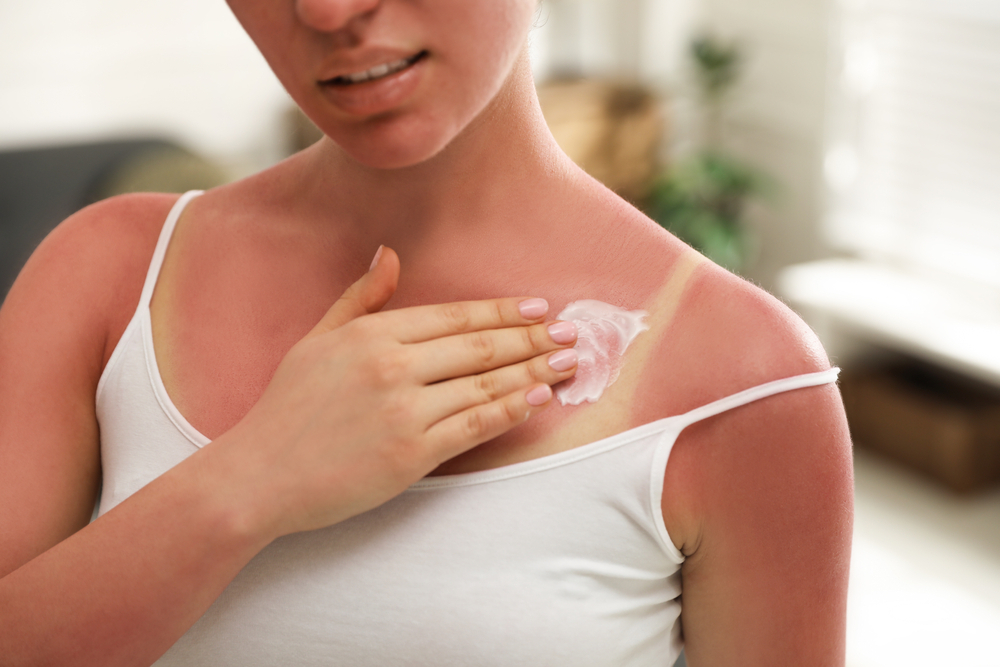Sometimes your best efforts to prevent a sunburn aren't enough. Perhaps you misjudged the ultraviolet (UV) index and let your guard down, or maybe you waited a little too long to reapply sunscreen. No one's perfect, and the occasional sunburn can happen for a number of reasons.
As your sun-damaged skin heals, treat it with extra care. This involves limiting your sun exposure and keeping it protected—but can you put sunscreen on burned skin? Discover the answer to this common question and tips to get your skin back to peak health ASAP.
How Do Sunburns Affect Your Skin?
The aftermath of a sunburn extends well beyond a short-term bout of red, irritated skin. Your skin is exposed to UV sunlight throughout your lifetime, often referred to as cumulative UV exposure. This exposure adds up over the years, accelerating a process called photoaging, or premature skin aging. Over time, the areas of your skin that have seen the most sunlight may be more prone to the visible signs of aging, like wrinkles, fine lines, and hyperpigmentation.
But sunburn prevention is about more than protecting your appearance. Repeated sunburns contribute to cumulative sun exposure and increase the risk of skin cancer. In fact, the Skin Cancer Foundation explains that sunburn is a leading cause of skin cancer, including squamous cell carcinoma and melanoma.
Can You Put Sunscreen on Burned Skin?
You can and should put sunscreen on burned skin. Sun-damaged skin is more sensitive to sunlight, and sun exposure can make an active sunburn worse. When you have a sunburn, avoid the sun while it heals and keep it covered if you need to spend time outdoors.
It's always important to protect your skin from sunlight, and having sun-damaged skin is a visible reminder of that. If you're dealing with an active sunburn, you can help it heal by preventing additional sun exposure. This includes applying sunscreen, seeking shade, avoiding direct sunlight during midday hours, and wearing sun-protective clothing and accessories.
Applying Sunscreen to Severely Burned Skin
Some symptoms of severe sunburn, like peeling skin and sun blisters, can make it difficult to apply sunscreen and uncomfortable to remove it at the end of the day. It's important that you don't pick at these areas to avoid infection and scarring. So, it's best to avoid sunlight completely instead of applying sunscreen to those areas and venturing outside. You can put sunscreen on peeling skin, though. A spray sunscreen like EltaMD UV AOX Mist may be more convenient than a sunscreen lotion in this case.
General Sunscreen Recommendations
What type of sunscreen is best for an active sunburn? The American Academy of Dermatology recommends a broad-spectrum, water-resistant sunscreen with SPF 30 or greater. Both physical (or mineral) and chemical sunscreens are effective at preventing sunburn, but physical sunscreens—those made with Zinc Oxide and Titanium Oxide—may be gentler on sensitive skin. EltaMD UV Physical Broad-Spectrum SPF 41 is powered by 100 percent mineral ingredients, making it great for damaged skin.
How Can You Care for Sunburned Skin?
Sunburned skin is extra sensitive and requires some TLC. The Centers for Disease Control and Prevention recommends the following tips to relieve sunburned skin:
- Take cool baths or showers.
- Apply a cool compress (but never ice!) to your skin.
- Avoid further sun exposure until your burn has healed.
- Use topical moisturizers containing Aloe Vera or Hydrocortisone.
- Use over-the-counter pain relievers.
- Keep sun blisters intact.
Keeping your sunburn moisturized is key, but avoid potentially irritating ingredients like alcohol. MedlinePlus also recommends avoiding petroleum jelly and creams that contain Benzocaine and Lidocaine. For an added soothing effect, put your moisturizer and sunscreen in the fridge before applying.
Keeping Your Skin Happy and Healthy
The importance of sunburn prevention can't be overstated. It reduces the risk of sunburn, sun damage, photoaging, and skin cancer—even in its deadliest form. However, mistakes happen, and you may end up with a sunburn or two in the future. When dealing with an active sunburn, protect your sun-damaged skin by avoiding sunlight, wearing sunscreen, and using sun-protective clothes and accessories. This will put you on the path to recovery so you can say hello to beautiful, healthy skin before you know it.
